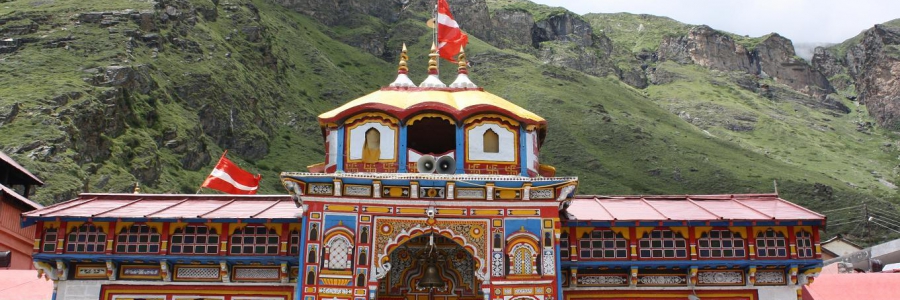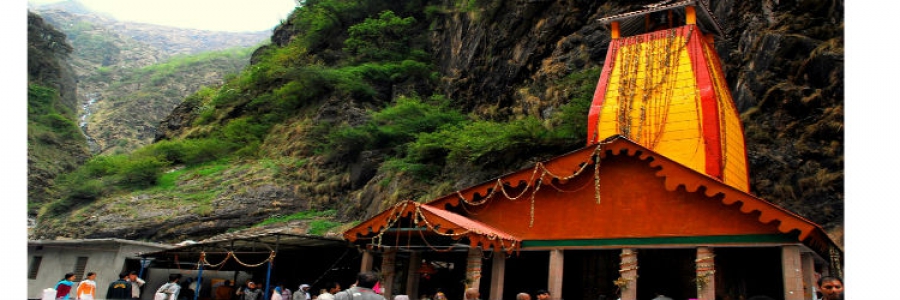11 Days - 10 Nights
- 2N Haridwar, 2N Barkote, 2N Uttarkashi, 2N Guptkashi, 1N Badrinath & 1N Rudraprayag
- Accommodation on Twin/ Double sharing
- Daily Breakfast and Dinner
- Darshan and Local Sightseeing during the entire trip
- Helicopter ticket for Shri Kedarnath Dham
- Escorted visit to Har ki Pauri Bhajan Sandhya aarti at Haridwar
- All transfers and sightseeing by A/C car (A/C & Music System in Vehicle will not be operated on the hilly area.)
Summary
| Hotel Picture | Hotel Envisaged | Destination | Nights | Approx Price |
|---|
Morning on Arrival at the Airport/railway station/pick up point, meet our drive to Haridwar, on arrival Haridwar check in Hotel. Later we shall take you to visit to the Har- ki- Pauri, Revel in Ganga Aarti in the Evening, later back to hotel for Overnight stay at the Hotel.
Depart from Haridwar early morning and stop for lunch on the way to Mussoorie . Continue your journey and reach Barkot in the Evening after visiting Kempty falls on the way. on arrival check in to the hotel, Dinner and Overnight at hotel.
Barkot - Yamunotri - Barkot {36kms drive & 6kms Trek (one side)}:
Drive to Jankichatti / Phoolchatti, trek start from here to Yamunotri (6kms). Either by walk or by horse or by Doli at own cost. Arr. Yamunotri, One can cook rice by packing it in a cloth and dipping it in the hot water of the hot kund. Pilgrims take this cooked rice home as "Prasad". Here near the temple "Pooja" can be offered to Divya Shila, After taking bath in Jamunabai Kund's warn water and having "Darshan" of pious "Yamunaji" returning to Jankichatti. Later drive back to Barkot. Overnight stay at Hotel.
Yamunotri Temple : Maharani Gularia of Jaipur built the temple in the 19th Century. It was destroyed twice in the present century and rebuilt again.
Surya Kund: There are a Number of thermal springs in the vicinity of the temple, which flows into numerous pools. The most important of these is Surya Kund.
Divya Shila: A rock pillar, worshipped before entering the Yamunotri Temple.
Barkot - Uttarkashi (100kms/4hr):
After a Relaxed breakfast, leave for Uttarkashi, Drive of 100 kms. Enroute visit Prakateshwar Cave, on arrival Uttarkashi Check in at the Hotel Evening visit Vishvanath Temple, Overnight stay at the hotel.
Uttarkashi: Situated at the bank of river Bhagirathi. The temple of Lord Vishwanath is located here where a massive iron trident is erected.
Uttarkashi - Gangotri - Uttarkashi (100kms/3-4 each side):
Early Morning drive to Gangotri (3048 mts), enroute we enjoy picturesque Harsil village, Bhagirathi River and the most magnificent view of the Himalayas . After Gangotri Darshan we return to Uttarkashi. Overnight stay at Uttarkashi.
Gangotri Temple : Gangotri temple is 18th Century temple dedicated to Goddess ganga. It is located near a sacred stone where king Bhagirath worshipped Lords Shiva. Ganga “Deva Yagna ”hear to atone the death of their kinsmen in the epic battle of Mahabharat. The temple is an exquisite 20ft.high structure made of white granite…..
Submerged Shivling: Submerged in the river, this natural rock Shivling is the place where, according to mythology Lord Shiva sat when he received the Ganga in his matted lock. It is visible in winter months when water level decreases.
Kedar Ganga Sangam: Around 100 Yards from the Ganga Temple flows the river Kedar Ganga. Starting from the Kedar Valle, this river meets the Bhagirathi on its left bank.
Uttarkashi – Guptkashi (220kms/8-9hr) :
After a very early Breakfast, leave for Guptkashi. a late lunch is Scheduled en Route molgarh. After lunch, Continue your journey and today for the first time see the Beautiful River Mandakni. Travel alongside the River to reach Guptkashi late in the Evening, Overnight Stay at Hotel.
Guptkashi – Kedarnath – Guptkashi (By Helicopter @ INR 9500 Per Person):
After breakfast at the resort you will fly to Kedarnath. Due to Government regulation, Due to massive floods last two year ago all accommodation facilities in Kedarnath have been damaged. Night halt will not be provided in Kedarnath , instead we will offer night halt facilities in Guptkashi/Rampur area .
We will offer VIP darshan slips at Kedarnath temple so our passengers can avoid the long queue and finish darshan quickly. The cost for these slips is Rs 2100 per person not included in our package. Any other special puja at Kedarnath can be0 booked at the local temple committee office although the cost for this will be paid directly by the passengers.
(Tour members should carry personal medicines, heavy woolen, toiletries and clothe)
Kedarnath Temple : The Kedarnath shrine, one of the 12 jyotirlingas of Lord Shiva, is a scenic spot situated, against the backdrop of the majestic Kedarnath range. Kedar is another name of Lord Shiva, the protector and the destroyer. According to legend, the Pandavas after having won over the Kaurava in the Kurukshetra war, felt guilty of having killed their own brothers and sought the blessings of Lord Shiva for redemption. He eluded them repeatedly and while fleeing took refuge at Kedarnath in the form of a bull. On being followed he dived into the ground, leaving his hump on the surface. The remaining portions of Lord Shiva appeared at four other places and are worshipped there as his manifestations. The arms appeared at Tungnath, the face at Rudranath, the belly at Madhmaheshwar and his locks (hair) with head at Kalpeshwar. Kedarnath and the four above-mentioned shrines are treated as Panch Kedar.
Kedarnath Temple:-The present temple built in 8th century AD by Adi Guru Shankaracharya lies adjacent to the site of an ancient temple built by Pandavas. Temple has a Conical Lingam - the assemblies of pilgrims and visitors. The temple is more than 1000 year old. Behind the Kedarnath temple lies the Samadhi of final resting place of Adi Guru Shankaracharya. It is believed that after establishing the four Dham in India he went for his Samadhi at an early age of 32 years….
Guptkashi - Badrinath (190kms/7hr):
After Breakfast leave for Badrinath via Joshimath. Check in Hotel. Later at evening visit Badrinath Temple for Aarti. Overnight stay.
Badrinath:- Cradled in the twin Mountain ranges of Nar and Narayan is the holies of the four main shrines-Badrinath along the left bank of Alaknanda with the towering Neelkanth peak as the splendid backdrop. Once the spot was carpeted eith “Badri” or wild berries and hence was famous as Badrivan.
Legend has it when the ganga was requested to descend to earth to help suffering humanity, the earth was unable to with stand the force of its descent, There for the mighty ganga was split in to 12 holy channels, Alaknanda was one of then that later became the abode of Lord Vishnu or Badrinath Ji…..
Badrinath one of the 'Four Dhams' is one of the most celebrated pilgrimage spots of the country and is situated at an elevation of 3,133 meters, This revered spot was once carpeted with wild berries. Thus the place got the name "Badri van", meaning "forest of berries".
Tapt Kund : Natural thermal springs on the bank of the river Alaknanda, where it is customary to bathe before entering the Badrinath temple.
Narad Kund : A recess in the river, near Tapt Kund, forming a pool from where the Badrinath idol was recovered.
Brahama Kapal : A flat platform on the bank of river Alaknanda. Hindus perform propitiating rites for their deceased ancestors.
Sheshnetra : 1.5kms. away is a boulder having an impression of the legendary serpent, better known as the Sheshnag's eye.
Charanpaduka : 3kms. away is a beautiful meadow where the footprint of Lord Vishnu is seen on a boulder.
Mata Murty Temple : Devoted to the mother of Sri Badrinathji. Other important temples include Sesh Netra Temple , Urvashi Temple and Charanpaduka.
Mana Village : Inhabited by an Indo-Mongolian tribe, it is the last Indian village before Tibet .
Vasundhara : As the name suggests, vasundhara is a magnificent water fall. This place is 5 kms. from Badrinath out of which 2 kms. is motorable up to Mana.
Bhim Pul : On the other side of Mana village, a massive rock forming a natural bridge, lies over the roaring Saraswati river. It presents a spectacular view of water thundering down through the narrow passage under the rock and is believed to have been placed there by Bhim, the second eldest among the five Pandava brothers.
Vyas Gufa (cave) : Near Mana Village, this is a rock-cave where Ved Vyas is believed to have composed the Mahabharata and the pauranic commentaries.
Badrinath – Joshimath - Pipalkoti - Rudraprayag (180kms/6-7hr):
Early morning, pilgrims after having a bath in the Taptkund have the Darshan of Badrivishal. Brahamakapal is significant for Pinddan Shraddh of ancestors (Pitrus). There are other interesting sightseeing spot like Mana, Vyas Gufa, Maatamoorti, Charanpaduka, Bhimkund and the "Mukh" of the Saraswati River. Just within the three kms of Badrinathjee. Later drive back to Joshimath - Pipalkoti - Rudraperyag. Check in Hotel. Overnight stay. Rudraperyag
Joshimath is situated on the slopes above the confluence of Alaknanda and Dhauliganga. Of the four 'Maths' established by Adi Shankaracharya, Joshimath is in the Badrinath to Joshimath and installed in the temple for people to worship. There are many temples in the township most important is the temple of Nir Singh in commotion of Lord Vishnu. The left arm of this deity is with time and the popular belief holds that the day the arm completely withers Badrinath valley will cease to exist and the Gods will transfer the residence into the neighboring Niti Valley at Bhavishya Badri. Joshimath is connected by regular bus service to Rishikesh, Haridwar, Badrinath and many other centers in the region.
Rudraprayag: It is the confluence of river Mandakini and river Alaknanda.
Rudraprayag – Rafting Shivpuri - Rishikesh Excursion - Haridwar ( 155 kms 7 hrs) :
After breakfast at the resort you will Shivpuri. Here you may opt to enjoy some adventure activities like River rafting, etc. on own. Take an excursion to Rishikesh. The 'place of sages' is a celebrated spiritual town on the bank of Ganga and is surrounded by Shivalik range of the Himalayas on three sides. It is said that when Raibhya Rishi did hard penances, God appeared by the name of “Hrishikesh” and this area hence firth came to be known as Rishikesh. Later visit Rishikesh Temples & Sight Seeing – Laxman Jhulla, Ram Jhulla, Bharat Mandir, Shivananda Ashram, Parmarth Ashram.. Overnight stay. Haridwar.
Rishikesh:Upstream on the banks of the Ganga where it is met by the Chandrabhaga is the holy town of Rishikesh. Literally, Rishi's (holy man) locks, this small town is the point where the holy Ganges crashes down in full glory onto huge boulders and creates long stretches of white sandy beaches. The banks are lined with ashrams, where saints and holy men rested before beginning their arduous pilgrimage up into the snow-covered land of the gods. Rishikesh is essentially a combination of five different districts- Rishikesh the commercial centre, Muni-ki-reti in the quiet suburbs, Shivananda Nagar to the north, Lakshmanjhula with its holy shrines and Swarg Ashram where most of the ashrams are located.
Swarg Ashram, with its numerous ashrams, food stalls and shops is a haunt for those looking for insights into religious themes. The newly constructed Ram Jhoola straddles the Ganga at this point. You can also make a river crossing on the ferries that run during the day. Important shrines and ashrams at Swarg Ashram include Kali Kumbliwale founded by Swami Vishudhananda, Parmarth Niketan with large statues of gods and goddesses and the Gita Bhavan with its Ayurvedic dispensary and shop selling religious books and cotton Khadi.
About 2 kms upstream is the old footbridge called Lakshmanjhula, named after the brother of Lord Rama. Temples line both sides of the river at Lakshmanjhula.
To the northeast is the area of Muni-ki-reti. Along the banks of the Chandrabhaga river, this area with its secluded white sand beaches is ideal for swimming. Boat rides on the river near Swarg Ashram are a pleasant diversion, and you can feed the fish that cluster around pilgrims throwing balls of wheat flour into the waters.
Haridwar – Delhi (220 kms drive 5-6 hrs):
Morning after Breakfast Drive to Delhi, On Arrival at Delhi transfer to Airport / Railway Station.
| Departure Dates | Tour Starting Price | Note |
|---|---|---|
| Departure Dates: May - June 24 |
20 pax travelling: INR 37199* Per Person |
|
| 10 Pax travelling : INR 38399* Per Person | ||
| 06 Pax travelling : INR 39399* Per Person | ||
| 04 Pax travelling : INR 45599* Per Person | ||
| 02 Pax travelling : INR 49499* Per Person |
Char Dham Yatra
Importance of Yatra:
Chardham Yatra have a great importance and significance especially among the people of Hindu religion. Pilgrims believe that Chardham yatra washes away all sins and opens doors for “Moksha”. Every human being should consider visiting these four Holy places at least once in their lifetime.
Millions of devotees visit this auspicious holy yatra and pay homage to the temples every year. It is commonly believed that undertaking a journey to these Pilgrim locations remove all sins as a human being whatever you have done in your past life. The yatra offers you sense of belongingness, heart Purity and act of self-actualization in life.
There are four Abodes in Himalayas collectively referred as "Chota Char Dham of India " and popular as "CharDham Yatra" which includes four holy shrines of Hindus: Badrinath, Kedarnath, Gangotri and Yamunotri. All of these temples are situated within the Garwhal region of Uttarakhand state in North India.
Among four Scared sites Kedarnath is dedicated to Lord Shiva while Badrinath is dedicated to Lord Vishnu. On the other hand, Yamunotri and Gangotri are dedicated to Goddess Ganga and Yamuna rivers respectively. In Hindu religion, the CharDham Yatra have a great importance, and it is considered that every hindu should do Chardham yatra at least once in a lifetime.
The following yatra tips will help to make your Char Dham Yatra comfortable, hastle free and will keep you healthy and fit during the entire trip.
- The chardham or the four pilgrimage destinations are accessible only for six months (May to October) throughout the year. The region becomes inaccessible during the other half of the part of the year due to snowfall. You can check opening and closing dates of Char Dham Temples.
- While visitng Hindu mythological sites, shrines and temples, one should remove shoes and cover head with a piece of cloth before entering the Holy Place.
- Carry heavy woolen clothes to protect from cold weather during the month of October-November and carry moderate woolen during Summer Season.
- Carry woolen Blanket, an umbrella, Raincoat, Torchlight, minimum luggage and canvas shoes with you. You can carry woolen sweater, monkey cap and muffler, which will enable you to with stand cold winds, at the upper level of Himalayas.
- Do carry creams, moisturizers, sunscreen creams.
- Pack a medical kit with painkillers, antibiotics, cough lozenges, Antiseptic cream, Iodine, tube-squeeze cream and medicines for cold and fever.
- Carry your routine medicines, as you might find only limited and general medicine at such remote locations.
- Carry dark choclates, dry fruits, Glucose (Glucon D), toffees. They will provide your instant energy during the trekking and during long jams.
- When asking for directions, speak to shopkeepers, not pedestrians. Check with at least two persons or more.
- Do not take pictures if cameras are not allowed in any particular area. Do not play with the sentiments of any particular religion.
- At least a month before the Yatra, it is advisable to start preparatory exercises for the trip 4 months in advance.
- Though self-managed tours happen to be economical, it is advisable for your Chardham yatra to go for a guided tour arranged by an expert local travel agent.
- Carry extra batteries and films for your camera, as electricity is not regular in such remote places.
- Do not travel in the rainy season as there are a lot of landslides during that time.
- Book hotel rooms in advance if you are travelling close to the temple opening dates, there is a heavy rush of pilgrims. Check hotels on CharDham Route.
- Alcohol or non vegetarian food is not permitted during Char Dham Yatra Tour.
- Drink packaged water or boiled water only.
Association
Member of TAAI, TAFI,& IATA accredited







.jpg)


